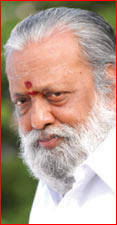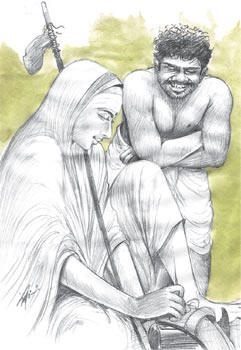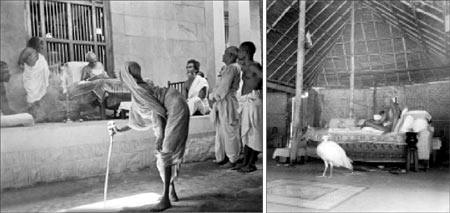Sakthi Vikatan
November 29, 2011
Tiruvannamalai Sriramanasramam published a Compendium of Reminiscences
titled
‘Niṉaivil
Niṛainthavai’
⸺
'Cherished Memories'
written by T.R.Kanakammal. This was written in simple Tamil, having
narration of sweet experiences, Tattvas…
This is unlike a biographical piece. It is Bhagavan from the perspective
of Kanakambal. The truths it reveals are amazing. 
Author Pramil has written a book on the Jñāni Sadhu Appadurai of Sri
Lanka, who said the following, ‘Satyam has no life story. It is
stupidity by a Jñāni to write a life story.
Birth, death and history are for
those with haughtiness. Abandoning haughtiness, a Jñāni has no birth, no
life and no death.
Connected with this, Ms. Kanakambal makes a remark.
A Sadhu queried Bhagavan, “If Ātma is all-pervasive, is it present in
the dead body?”
Bhagavan counter-queried the Sadhu, “Did this question come to you? Or
did the question occur to the dead body.”
Sadhu: “To me.”
Bhagavan: “Do you have a doubt about yourself as to whether you exist in
sleep or not? Only after you wake you say. ‘I am.’ Likewise, Ātma
remains in the dead body.” “If you enquire into the Truth, there is
neither a dead body, nor a living body. The moving body, we call, a case
of rebirth. The immobile body, we call, ‘dead.’
We see in our dream sleep, the dead, the living and more. On awakening,
they are no more. Likewise, life is a reverie. This (life) is sleep, a
dream. Nothing is here in truth.
Death is absence of the self-sense, “I.” Birth is the sprouting of the
“I-factor.” This sprouting manifests (எழுச்சி)
as Ahaṅkāram (Ego). Ahaṅkāram takes birth and ends in death. When “I”
exists, you exist. Even when the “I” is absent, the “You” still exists.
You cause this manifestation; You are not the manifestation itself.
Knowing this origin, you must die with understanding. Have a clear idea
of death before the death of the body. Having died with that knowledge,
he takes a rebirth the moment he realized the knowledge of ‘Aham’,
‘Ātmam’,
‘I
am Ātmā’
(Aham = I, Myself; Ātmam = soul; I am Ātmā = I am the soul). This is not
the birth of the body. It is the manifestation or awakening of the mind.
The awakened individual, the one born as Ātma has no doubt in the
paradigm of non-difference in ‘Death-the Living-Death-the Living.’ Bluff
and bluster of ‘I am,’ creates karma. Simultaneous hubris engenders
doubt in himself, ‘Am I what I think I am.’
This hard-to-know-subtle concept, Bhagavan makes us understand with
ease. Clarity on this subtle concept, can never be found elsewhere.
Bhagavan: “You say you know nothing.
Who are you, to say thus? If you know the answer to it, you
assume you know everything and your ego becomes stronger. Is it not
better not to know anything?
A woman new to the Āśramam said to Bhagavan, “I have only one
supplication. Could I ask you?”
Bhagavan: “Ask me.”
The woman: “I want Moksa (liberation). “
Bhagavan: "Oh, Is that so?”
Woman: “Yes, I have no other desire. Moksa alone, if given to me, that
is enough. Please don’t say ‘I will give it you one day.’ I need it now
(and not tomorrow), Swamy. Can you give me.”
Bhagavan: “You figured it out, didn’t you?
Liberation now. Nothing else. Is it a bag, a packet…, that I can
dispense? No other desires, it seems. Only this desire. If you remove
the desires and passions from your mind, what is left is Moksa. You
should do Sadhana to attain it.”
Some visitor to Āśramam drew with white flower an image of a peacock.
The strutting peacock leaving aside its feed looked at the
drawing intently.
Bhagavan seeing the motionless peacock watching the drawing asked the
bird with laughter, “Do you think a competitor has come to take your
place?” (Understanding the nuanced message from Bhagavan) immediately
the peacock gave up its look-see of the drawing (Kolam) and strutted
away to eat its feed on the ground. That drawing was so realistic even
the peacock was impressed.
The Kolam maker drew accolades from everybody.
Bhagavan Seeing the Kolam: “Artists of this nature learn Ātma Vidya very
easily, because their keen intellect is so very subtle. But, they will
not advance any further (beyond their art.).”
“The peacock Kolam that made the peacock bewildered will one day make
another peacock take notice and dance. To that extent, the Kolam should
be improved. Buddhi goes in the pursuit of such thoughts. It does not
make inward journey.
It is not enough for the enthusiasts to pay accolades to the musical
Vidvan. Another musical
Vidvan of equal caliber should praise him. There lies the satisfaction.
Here the peacock itself paid tributes to the peacock Kolam.
Once a man with an air of erudition sat before Bhagavan. He showed a
desire to query Bhagavan. Having disturbed the collective silence of the
attendees, he posed a question.
“Ramakrishna Paramahaṇsa induced Samadhi in Vivekananda by mere touch.
Likewise, can you do the same?”
Bhagavan did not answer the question and maintained silence.
The youth exhibited the impatience of waiting for the answer.
A little while later, Bhagavan looked at the youth and posed the
question, “Is the asker, Vivekananda?”
The youth could not answer the question. A little while later, he lost
his cockiness and moved away from his place.
No one worries about his own status. The thought of (feigned)
omniscience blinds them. Not indulging in self-enquiry, they inquire
into others. This intrusive enquiry begets trouble.
The youth’s notion was, “What a show this is? He is sitting in his sofa
in comfort, surrounded by many admirers. What is his greatness? Is he
capable of demonstrating what I asked of him? Let us see.”
He was testing me to know whether I was of the caliber of Ramakrishna
Paramahaṇsa. But, it did not occur to him whether he was of the same
caliber of Vivekananda. He
thought he had all the qualifications. If he indulged in ‘Who am I?’
this question would not have risen in his mind. He did not understand
Ramakrishna induced Samadhi in (qualified and deserving) Vivekananda
only (and in no other person). (That speaks of readiness of Vivekananda
to receive his Guru’s grace.)
Bhagavan says, “The mind should analyze oneself instead of others. You
will realize all questions have answers in oneself.”
Let us do Darśan

